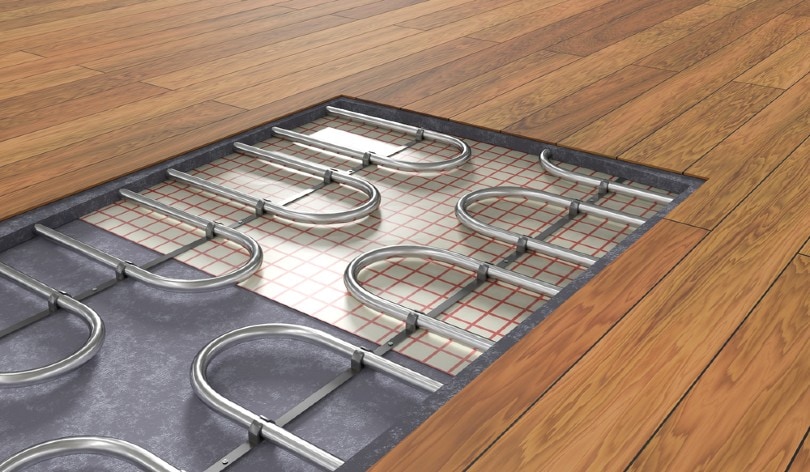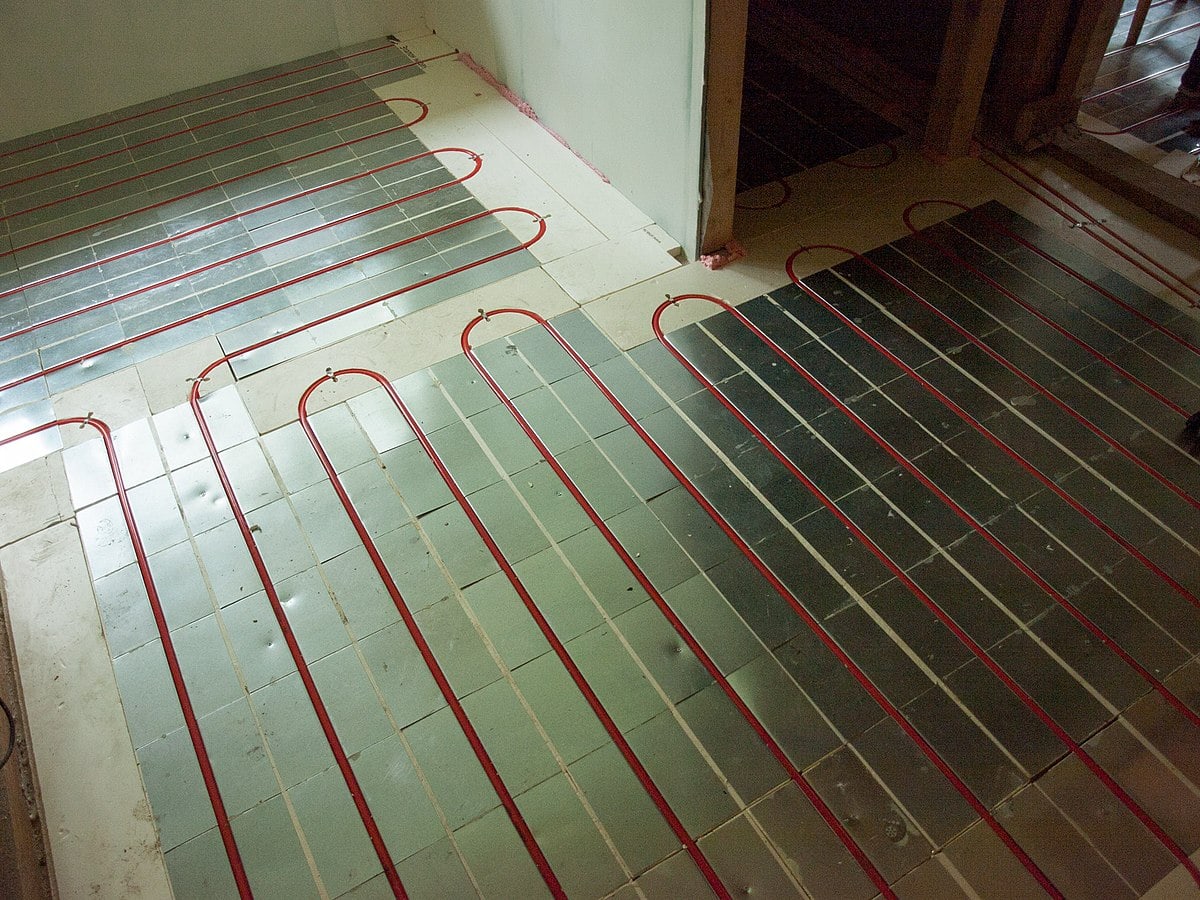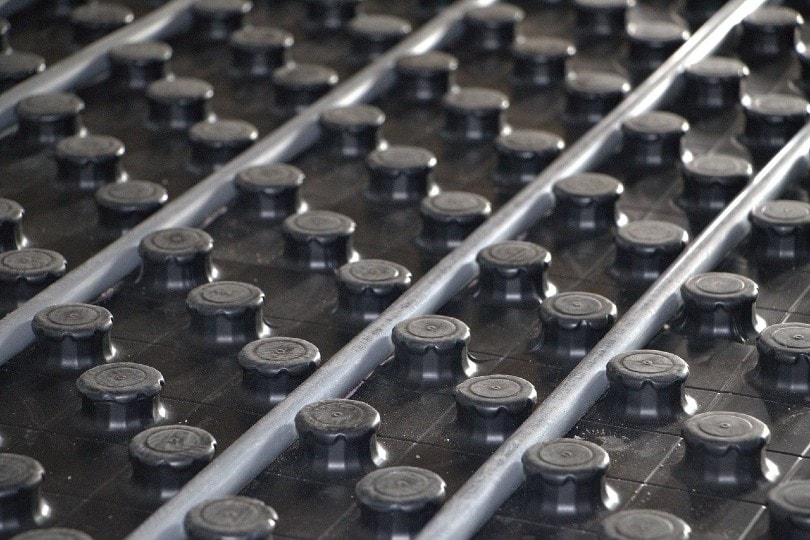Radiant Floor Heating – Pros, Cons & How It Works
-

- Last updated:

Radiant floor heating is arguably one of the best home heating systems. It is efficient since it does not blow dust like most hot air systems. Radiant floor heating system (RFH) is different from most others as it does not overheat the room. The heat is generated from below the floor, providing an equal and even heat distribution throughout the entire house.
RFH will also heat the house differently compared to most radiators. It can be compared to how you feel when you stand next to a window on a sunny day. You will warm up without needing the sun to heat the air outside.
Keep reading to learn more about radiant floor heating, how the floor heating system works, and its pros and cons.

A Brief History of Radiant Floor Heating
Radiant floor heating systems date back to ancient times when the Romans would run flues for slave-tended and wood-burning fires under marble floors which would, in turn, heat the whole room.
Centuries down the line, in America, copper pipes were used in Usonian homes and were warmed with warm water, which warmed up the floors and consequently the whole house. A few people followed suit, including Levittown, but the pipes would eventually corrode and jackhammer the floors.
Currently, plastic PEX tubing is the preferred alternative and has long since replaced metal as a way of heating the floors.

How Does Radiant Floor Heating Work?
Imagine waking up on a cold, snowy morning, only to get out of your warm bed and step on a cold hard surface. The feeling can get you hopping back in bed.
What if you wake up to a warm floor, allowing you to continue with your duties in a cozy environment? You will find it easier to prepare yourself for work, and have a better morning for you and your family.
Radiant floor heating involves the installation of electric heating coils, or water-heated tubing throughout the house under the flooring, which warms it from the ground up.
Think of it this way: on a sunny day, if you step from the shade and into the sun, you will feel warmer without changing air temperature. This is how radiant floor heating works. Compare this to a central heating point which only heats a certain area and expect that with air movement, where hot air rises and cold one falls, the whole house will eventually be warmed up. This is disadvantageous as it results in uneven heating where you may find your toes freezing, but your head is hot.
Aside from the warmth, most people look for the economic advantage of RFH systems. Certain RFH systems can slash the cost of heating by between 25% and 50 %. New homes are best placed to get these innovative RFH systems, but older homes can also be fitted.
Find a flooring specialist in your area, and get free, no-commitment estimates for your project.Consult a flooring expert

Types of Radiant Floor Heating Systems
There are at least three different kinds of radiant floor heating systems, including:
- Air-heated radiant systems
- Electric radiant heating systems
- Hydronic radiant heating systems
Air-Heated Radiant Systems
Air-based radiant floor heating systems are not as preferred compared to their counterparts. For one, air cannot hold a large amount of heat, and even after being combined with solar air heating systems, they can only manage to produce heat during the day.
The other problem is that they are not cost-effective, as you might have to spend more on an alternative means of warming the floors night.
Electric Radiant Floor Heating Systems
Electric radiant floor heating uses plastic mats that are heat-conducting and have coils warmed electrically.
The heating coils are not the typical heated elements you would find in an electric stove; rather, they are resistant wires, mostly copper or nichrome, which come wrapped in a water-resistant polymer.
Nichrome is an alloy belonging to the nickel and chromium family and has high electrical resistance, making it ideal as a heat producer.
These wires are then zigzagged through a mat and connected to electricity; think of it as a large rolled-up electric blanket but now without the fabric.
During installation, the contractor will roll out the mats and put the flooring material as it should be.
Most people will mostly carry out selective flooring in certain rooms of the house. This is due to the high cost of electricity and lighting up the whole house. However, certain options may reduce the cost, such as fewer charges by your electric company for off-peak usage. Cheaper rates, especially at night, will allow for less cost of charging the heating elements, which can then be used over the course of the following day.
When it comes to flooring, electric radiant floor heating works best with floors made from ceramic tiles but can still be used on different types of flooring, including hardwood floors. Carpets may be problematic, as they are not as good as hardwood or tiles in terms of conducting heat, but with the right padding on the carpet, you may still be at a good place.
You can get two kinds of padding, including slab and ribbed padding, where slabs are flat while ribbed are waffle-like in pattern. It is also recommended that you get a 68 centimeter or 3/8 inch slab foam rubber pad with your electrical RFH system.
Electric RFH systems coils are installed between the subfloor and the floor covering, reducing the heating time, typically between 30 minutes and one hour. The system is turned on simply by flicking a switch or through a thermostat.
For a small room, you will spend between $400 and $500 to install an electric RFH system. You will also need a qualified electrician, even if you choose to do the installation yourself. In addition, if you decide to install it on an already built house, you may incur the extra cost of having to tear up the flooring.
Hydronic Radiant Floor Heating Systems
If you want to warm up the whole house, then the Hydronic radiant floor heating system is the way to go. The amount of money it would take to warm up a house electrically is too much, making this option the most viable.
Before putting up a Hydronic radiant floor heating system, understand that the set-up will cost you more than a typical standard furnace. The cost may run up to $3,800 to $4,500 for a 2,000 square foot home.
A Hydronic radiant floor heating system that comes with a boiler will cost you upwards of $7000. It is, however, more efficient and will last longer, between 35 and 40 years, compared to standard furnaces that last between 10 and 25 years.
An advantage of the Hydronic radiant floor heating system is that it will use a variety of sources to heat the water, including:
- Oil-fired boiler
- Gas-fired boiler
- Kerosene, gas or solar
Depending on where you live, the size of your house and how cold it is, you can decide the best heat source to use. For example, if you are in a place as cold as Canada, you may need a boiler, while areas like Florida can see you get away with a regular water heater.
The installation has to be done professionally. There are two kinds of installation available for the Hydronic water system including:
- Wet
- Dry
For the wet installation, you will add a slab of concrete under the subfloor or a thin sheet of concrete between the subfloor and surface.
For the dry installation you will place the tubes under the subfloor while constructing with no concrete on top. The rest of the materials, including the flooring surface, tile and carpeting, go on the subfloor and pick up the heat from the tubes.
The concrete will act as a substance for holding the heat, meaning you have a huge warm block under the house that ensures you stay warm. Concrete has low conductivity, meaning it has a high chance of retaining heat; on the other hand, wood has a high conductivity.
Systems with wet installs take a lot more time to heat up, meaning they need to run longer, but dry install will work at way higher temperatures as they do not have a thermal mass to store the heat.
The RFH is directed from a single source point but it can also be programmed to work in different areas separately, depending on the owner’s preference. It is linked to a manifold, a system where water is channeled separately.
With the help of a thermostat, you can separately heat different areas of the house. The water will pass through PEX tubing, a leak-free and flexible polythene tubing that makes it easier to separate the water, enabling differential warming of the house.
In terms of maintenance, the Hydronic system will require minimal support, with things such as annual checkups; otherwise, you are good. However, it is possible that the RFH can break down and need professional inspection.

Pros of Radiant Floor Heating
1. Effortless to Run
After installation, radiant floor heating will require little to no maintenance for up to 30 years. Your heating will run efficiently with efficient temperature control with a thermostat, either little checkups being the only required maintenance.
2. More Space and Design Freedom
With Radiant floor heating, you no longer need wall heaters which take up huge spaces on the walls. This allows a lot of design control for your walls where you can decorate as you want.
3. Works with Floor Coverings
Radiant floor heating allows you to design your floors as you desire. It will not impact the kind of flooring you wish to have in your house. It will work with laminate, wood, tiles, stones and carpets.

4. Energy Efficient Heating
You will have several options for RFH systems including electric, water and air-based systems. In addition, the REFH will work to warm up the whole house, compared to traditional radiators, which warm up the house differentially.
Traditional radiators will also require being heated to high temperatures to warm up the whole house. On the other hand, floor heating will require heating up to around 84 degrees Fahrenheit, which is 29 degrees Celsius. Radiators will go up to 65 degrees Celsius.
5. Safer to Use
You no longer need to lie with the risk of touching and burning yourself on the radiator or finding some hot surfaces. RFH is safely tucked away, and due to even heating, no areas get hotter than others.
RFH also maintains a great air quality, maintaining a rich level of fresh oxygen compared to other heaters, which warm up the air.
6. Ease of Installation
RFH is easy to install, especially on a new or renovated project, and can be done with as little as two people.
Disadvantages of Radiant Floor Heating
1. Installation Cost
RFH is very expensive to install at around $10 to $20 per square foot, depending on the kind of RFH you want installed.
You also need a qualified professional to help with the installation, which may run up to $200 to $250.
Other kinds of RFH such as water systems will be installed while the house is being built and may cost you up to two or three times the sum of installing an electric RFH system.
2. Installation Time
It may take days for the RFH system to be installed, as the underfloor needs to be completely dry before the floor covering can be put in place. Water RFH systems may even take longer, although this won’t matter as it is mainly done during the construction or renovation phase of the house.
Summing Up
Radiant Floor Heating systems are way worth it and will provide some much-needed comfort in your home. Although they are expensive to install, they will last longer and require little maintenance, making them worth the price.
Always consider your options before making a purchase and correlate that with where you live and the kind of house. Otherwise once put in place, you are all set except for the occasional routine maintenance.
Featured Image Credit: vchal, Shutterstock
Contents



